SOFTWARE FOR GLASS
GlasSave Glass Optimiser
Why optimise glass?
Without doubt, the viability of any company converting large fixed size sheets of glass into smaller, variable pieces depends primarily on their ability to minimise the waste. Although the source, or stock sizes, remain fairly static, nearly every piece to be cut will have different dimensions, so there is no standard pattern for cutting; every hour of every working day, the problem changes.
GlasSave from Clear Thinking is designed to produce cutting diagrams and labels to enable you to cut glass orders from stock sheets in the most efficient way, in the shortest possible time. GlasSave is capable of giving excellent results with either “man-handleable” stock sheets (e.g. 2440 x 1320mm etc) and full (6000 x 3210) or split (3210 x 2100) jumbo sheets.
There are thousands of different ways in which just a few different pieces can be cut out of a standard stock sheet; most patterns would be extremely wasteful, and many would be difficult to cut. So, if you cut glass (or any other sheet material for that matter, eg. marble, steel etc.) out of stock sheets, then you may be wasting between 15-30% using manual methods. Using GlasSave, we can consistently reduce the waste to between 3-6%. Imagine an extra 10% (or even 20%) discount off your current glass bill. Obviously, this can represent enormous cost savings, and can mean that the computer system will pay for itself in just a few weeks.
Generally, optimising gives better results if it can select from a reasonably large number of orders, with a variety of sizes, giving it a wide choice of combinations to fit on a stock sheet. Order management is therefore very important, to constantly monitor the balance between building up efficient large batches of orders for the optimising, yet ensuring that delivery dates are met.
GlasSave can also simplify production by optimising in a number of different methods, to suit your current production, including random cutting, repeat cutting, mirror cutting and direct pairing, and the program can link to most glass cutting tables (see below). Comprehensive help screens are available and can be user-defined for the specific needs of your site or operator.
Sealed unit manufacturers may find spacer bar cutting reports useful to cross-reference the spacer sizes with the pairs of glass used to assemble the sealed unit.
And remember, thousands of companies have successfully mastered the computer and are now reaping the benefits described above. Maybe some of them are, or soon will be, your competitors.
Facilities and options available in GlasSave
The GlasSave main program includes the ability to type in ordered glass sizes manually, to amend these orders if necessary and to optimise clear and patterned glass out of several different sizes of stock sheets simultaneously. The program will produce detailed cutting diagrams suitable for manual cutting or for operating a semi-automatic table. (See below for automatic cutting table links.) GlasSave will use X cuts, Y cuts, Z cuts, and even W cuts to improve yield. You can adjust the minimum break out/snap off to suit each glass type and it understands about Low E glass and edge deletion of soft coat glass. It is also aware of coated glasses (eg. self cleaning glass), which must be cut face up. Although most customers use it for annealed or float glass, you can also turn off W and Z cuts for cutting laminate glass. It can cut trim cuts on the sides of the sheets of glass if they require it.
GlasSave can optimise in a number of different ways to suit your current production methods:
Random Cutting: either piece of a unit can be placed anywhere on any sheet within a batch; a reference number is used to help match the pieces together. This method will usually provide the maximum yield, but care must be given to the handling and racking of glass, see further notes on GlasSave’s sophisticated racking to help with factory throughput. Here is a sample screen shot, showing the letter A or B to designate a trolley, followed by a number to show the slot the piece of glass will be put in.
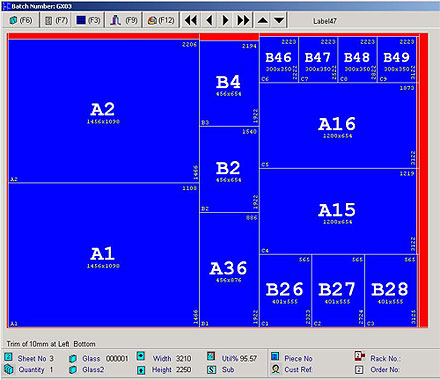
Repeat Cutting: each stock sheet pattern is cut twice to enable the two pieces of a unit to be kept on consecutive stock sheets. This can only be done if the stock sheets are the same size for both sides of the double glazed unit.
Mirror Cutting: the two pieces of a unit are again kept on consecutive stock sheets, but this method can make handling the pieces easier, as the second sheet is the ‘mirror image’ of the first, so that the first cut piece of the second sheet will match the last piece from the previous sheet.
Direct Pairing: both pieces of glass are kept on the same stock sheet with two pieces near or next to each other.
Label Printing: GlasSave gives you the ability to design your own label layout and print labels for each piece of glass or unit. Any size labels can be produced with logos and barcodes and they can be printed out singly or side by side on A4 sheets using laser printers. Clear Thinking can supply a variety of labels, please click here for more information.
Spacer List printing and Sealed Unit racking: The racking can be sorting in many different ways, to suit your factory.
Links to other Programs: GlasSave will accept information from a number of other order processing packages including Glass Office, Windowmaker (Windowmaker Software Ltd), Window Designer (First Degree Systems Ltd), Evolution and Winstar (Business Micro’s), Caliburn (Merlin Software International) and Eden (Windowlink Ltd) to save re-keying of glass sizes, obviously saving time and reducing errors.
Offcut Re-utilisation: Any offcuts that have been designated as re-usable will be stored and can be automatically used on subsequent optimising runs.
Shape Cutting: Providing your cutting table has the facility, any shape can be cut, whether it is a regular shape from our shape library, or a unique DXF CAD shape. With the shape nesting option, these shapes can be rotated and nested to increase yield enormously compared to manual methods. See sample screen shot.
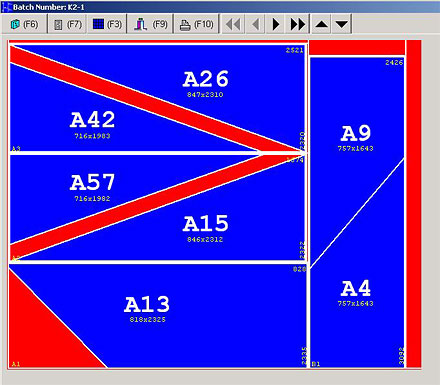
Predetermined Shape Library: If certain shapes are cut regularly, eg. coach tops of a certain size, then these can be stored away for recall later.
Cutting Stock Sizes: Standard stock glass sizes, eg. fanlights, can be selected from a library and slotted into cutting patterns to improve the optimisation.
Custom Edge Deletion: A wider grind can be accomplished based on the required spacer depth or if a unit is stepped click here for more details
Links to Cutting Tables: GlasSave links to most types of fully automatic cutting tables, and will produce output suitable for semi-automatic tables. The cutting information can be transmitted by way of a network cable (or floppy disc) resulting in a quick, controlled and reliable method of satisfying your orders.
Cutting Tables that GlasSave can link to
Bavelloni
Berlyne Bailey (Trucut & GCT69)
Bola / Bolla
Bottero
Bottero Laser (see a video of Bottero lasering in action)
Bystronic
CMS
Columbo
Contract Developments
Copmes/Coopmes (Duara, Prima & 3 others)
Elco Piccola
Exceldee CostCutter (XLD)
GMS
Hegla
Hegla Laser (see a video of Hegla lasering in action)
Hegla Remaster
Intermac
Italmec
Lisec
Machine Techniques (USA)
Machine Technologies (MTL)
Machines and Tools – MTL Cougar, MTL Panther & MTL Puma
Macotec (Sharpcut, Panther, Supercut)
Pannkoke
Perfect Technologies (Perfect Tinning) (USA)
Powergrind (Unicut)
Promac
Siemens (Bassra Machine Tools)
Turomas
Links to Saws and Spacer Benders: GlasSave links to most types of saws and spacer bender machines.
Saws and Spacer Benders that GlasSave can link to
Atlantic
Bystronic (Lenhardt)
Contract Developments
Forel
Lisec
Machine Technologies (MTL)
Machines and Tools – MTLCCS
Promac (Pro-cut)
Rivers
Rjukan
Ulmke
GlasSave Racking
(to read a Racking case study, please click here)
When glass is cut it can be racked into a slot, to prevent scratching. GlasSave can sort and rack your cut glass in many ways to suit your production layout and required throughput.
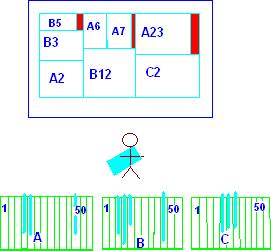
Each piece is given a rack number (eg. B12 means trolley B slot 12).
This racking can be sorted so that, for example
a) all units are sorted to suit a spacer bending machine, then sub-sorted into delivery route sequence, and then customer sequence and then size sequence (so that it’s easier to load the stillages with the largest pieces of glass first). This is because the spacer bender is most efficient when bending all of the same type of spacer bar at once (ie. not changing colour or thickness too often)
b) all units could be sorted into customer and job sequence, then in size sequence, to keep all of a customer’s work together and each job together
c) all toughened glass can be cut in separate trolleys (to go to be arrised and toughened)
d) all decorative products (leaded and stained designs and applied bevels) can be sorted into one trolley to go to the decorative department
The trolleys used are similar to these, they can have between 50 to 100 slots per trolley and are available from a variety of manufacturers.
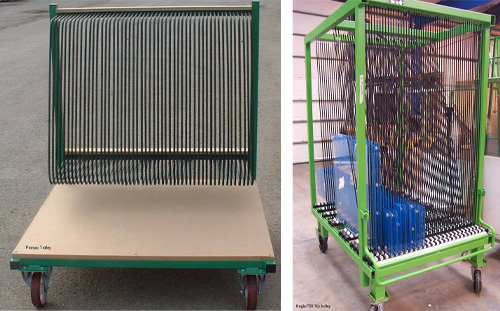
We usually will visit a client to give specific advice about how this can be achieved, but here we will give three examples.
1. Racking without a Spacer Bending machine
Usually the requirement for racking is to cut glass efficiently (to save money on glass). But in doing so, you should not have to employ extra staff to sort all the optimised pieces of glass back into a useful sequence (so wasting money on labour). This just “robs Peter to pay Paul” and is pointless.
If a business hasn’t optimised before, it is usually most comfortable making all of the units for one job at a time, followed by the next job, and so on. In this case, we can configure the racking to emulate this requirement, so that you get the reduced wastage of batching (eg) 100 units together, but the work is sorted, so that everyone else in the factory gets all of units for the first job before they get any of glass for the second job, and so on. We would usually enhance this by additionally sorting by customer, so that all of one customer’s jobs are all together. This helps with delivery, and usually spacer cutting as well. We could go further and sort by size within job (largest down to smallest) to aid stacking of the units as they are completed, if required.
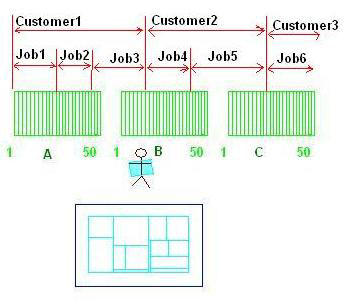
2. Racking with a Spacer Bender machine
Usually the spacer bender takes several seconds to switch between one type of spacer bar and another. This means that you don’t want to change the type or colour of the spacer bar too often in a day, or a batch of work. So, we can sequence the sorting, so that all of one spacer type is cut at once, to speed up the production. We also provide a disc for the spacer bender with all of the spacer sizes on, in the correct sequence. See below for an example of this.
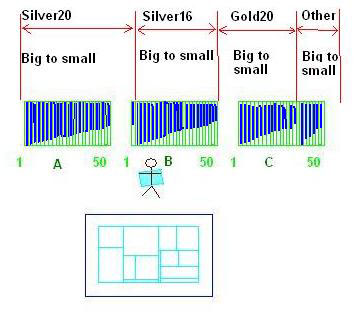
3. Racking by Type of Glass
Some customers want to separate glass into different trolleys based on what will happen to it. For example, all of the plain annealed glass can be grouped together and be made immediately into units. All of the decorative product (lead and applied bevels) can be taken over to the leading department to be leaded, etc. And all of the toughened when it arrives (from an external supplier), can be loaded onto a trolley in the correct rack sequence, and made at any time of day, independent of the other work – this means that if the toughened is early or late, it doesn’t hold up production of other units.
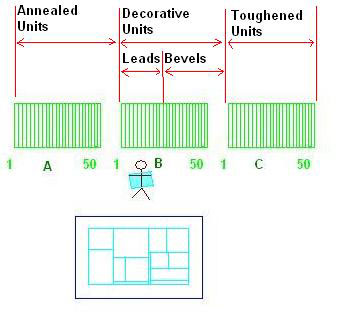
Many more combinations of racking and sorting are available, but this should give you a taste of the way it works, to speed up production in the factory, whilst keeping wastage low.
GlasSave is the new windows version of the MS-DOS optimisers, also marketed variously as Optimax, Acuglas, EZOpt (or EZ-Opt), Quickopt. It is also the engine that is used for e-optim.com
Some of the file formats that we’ve used in GlasSave are GO2GS.DAT, GO2GS2.DAT, GO2GS3.DAT, GO2GS4.DAT etc (Glass Office), KMOPT.DAT, KMOPT2.DAT (Unit Manager), LMOPT2.DAT (Window Manager), WMOPT2.DAT (Windowlink), GPOPT2.DAT (GlassPro/Highway Electronics), CASFILE0.000 (Powergrind), OPT101.CNC (Lisec), *.XL3 (Exceldee), *.OPT (Contract Developments), *.CUT (Bottero), *.PMC (MTL/Promac), *.EDI (Hegla), *.PLC and *.PGM (Copmes), *.mpf (Bassra), *.pap (Columbo), *.r01 (Macotec), *.FIL (Lisec bender), *.MBC (Rjukan), *.SAW (MTL /Promac spacer bar saw)
